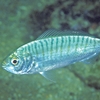General Description
Robust head and body, tapering toward tail base; head rather smooth, armed with low spines, eyes large; anterior dorsal-fin spines very long, only connected at base; pectoral fins large, not reaching beyond anal fin origin; underside of lower jaw with many tiny pores on either side. Greyish to mottled red above with 3 diffuse darker saddle-like bands, underside pale; spinous dorsal fin with 2 dark blotches. To 40 cm.
Biology
The largest scorpionfish in Port Phillip Bay, and occasionally taken on hook and line. It is considered very good eating and taken in commercial trawls. The fin spines are venomous and can inflict a very painful wound.
Habitat
Hard bottom areas in bays and along the coast, in depths of 1-180 m.
Reefs
Distribution guide
Southern Australia.
Species Group
Depth
Shallow (1-30 m)
Deep ( > 30 m)
Water Column
Max Size
40 cm
Diet
Carnivore
Harmful
Venomous spines can inflict mild to severe pain.
Commercial Species
No
Global Dispersal
Native to Australia
Conservation Status
- DSE Advisory List : Not listed
- EPBC Act 1999 : Not listed
- IUCN Red List : Not listed







